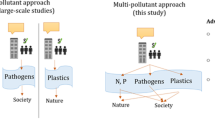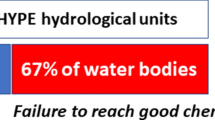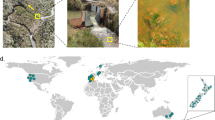Abstract
Wastewater discharges from publicly owned treatment works are a significant source of endocrine disruptors and other contaminants to the aquatic environment in the US. Although remaining pollutants in wastewater pose environmental risks, treated wastewater is also a primary source of stream flow, which in turn is critical in maintaining many aquatic and riparian wildlife habitats. Here we calculate the dilution factor—the ratio of flow in the stream receiving discharge to the flow of wastewater discharge—for over 14,000 receiving streams in the continental US using streamflow observations and a spatially explicit watershed-scale hydraulic model. We found that wastewater discharges make up more than 50% of in-stream flow for over 900 streams. However, in 1,049 streams that experienced exceptional low-flow conditions, the dilution factors in 635 of those streams fell so low during those conditions that the safety threshold for concentrations of one endocrine disrupting compound was exceeded, and in roughly a third of those streams, the threshold was exceeded for two compounds. We suggest that streams are vulnerable to public wastewater discharge of contaminants under low-flow conditions, at a time when wastewater discharges are likely to be most important for maintaining stream flow for smaller sized river systems.
This is a preview of subscription content, access via your institution
Access options
Access Nature and 54 other Nature Portfolio journals
Get Nature+, our best-value online-access subscription
$29.99 / 30 days
cancel any time
Subscribe to this journal
Receive 12 print issues and online access
$259.00 per year
only $21.58 per issue
Buy this article
- Purchase on Springer Link
- Instant access to full article PDF
Prices may be subject to local taxes which are calculated during checkout




Similar content being viewed by others
References
Clean Watersheds Needs Survey 2008 Report to Congress Report No. EPA-832-R-10-002 (USEPA, 2010).
Schwarzenbach, R. P. et al. The challenge of micropollutants in aquatic systems. Science 313, 1072–1077 (2006).
Carey, R. O. & Migliaccio, K. W. Contribution of wastewater treatment plant effluents to nutrient dynamics in aquatic systems: a review. Environ. Manage. 44, 205–217 (2009).
Benke, A. C. A perspective on America vanishing streams. J. North Am. Benthol. Soc. 9, 77–88 (1990).
Allan, J. D. & Flecker, A. S. Biodiversity conservation in running waters. Bioscience 43, 32–43 (1993).
Dynesius, M. & Nilsson, C. Fragmentation and flow regulation of river systems in the northern 3rd of the world. Science 266, 753–762 (1994).
Ricciardi, A. & Rasmussen, J. B. Extinction rates of North American freshwater fauna. Conserv. Biol. 13, 1220–1222 (1999).
Richter, B. D., Braun, D. P., Mendelson, M. A. & Master, L. L. Threats to imperiled freshwater fauna. Conserv. Biol. 11, 1081–1093 (1997).
Brooks, B. W., Riley, T. M. & Taylor, R. D. Water quality of effluent-dominated ecosystems: ecotoxicological, hydrological, and management considerations. Hydrobiologia 556, 365–379 (2006).
Barber, L. B. et al. Persistence and potential effects of complex organic contaminant mixtures in wastewater-impacted streams. Environ. Sci. Technol. 47, 2177–2188 (2013).
Bradley, P. M. et al. Riverbank filtration potential of pharmaceuticals in a wastewater-impacted stream. Environ. Pollut. 193, 173–180 (2014).
Bradley, P. M. et al. Pre/post-closure assessment of groundwater pharmaceutical fate in a wastewater-facility-impacted stream reach. Sci. Tot. Environ. 568, 916–925 (2016).
D’ Alessio, M., Yoneyama, B. & Ray, C. Fate of selected pharmaceutically active compounds during simulated riverbank filtration. Sci. Tot. Environ. 505, 615–622 (2015).
Hubbard, L. E. et al. Understanding the hydrologic impacts of wastewater treatment plant discharge to shallow groundwater: before and after plant shutdown. Environ. Sci. 2, 864–874 (2016).
Schwarzenbach, R. P., Egli, T., Hofstetter, T. B., von Gunten, U. & Wehrli, B. in Annual Review of Environment and Resources Vol 35 (eds Gadgil, A. & Liverman, D. M.) 109–136 (Annual Reviews, 2010).
Ternes, T. A. Occurrence of drugs in German sewage treatment plants and rivers. Water Res. 32, 3245–3260 (1998).
Petrie, B., Barden, R. & Kasprzyk-Hordern, B. A review on emerging contaminants in wastewaters and the environment: current knowledge, understudied areas and recommendations for future monitoring. Water Res. 72, 3–27 (2015).
Kortenkamp, A. Ten years of mixing cocktails: a review of combination effects of endocrine-disrupting chemicals. Environ. Health Perspect. 115, 98–105 (2007).
Pojana, G., Gomiero, A., Jonkers, N. & Marcomini, A. Natural and synthetic endocrine disrupting compounds (EDCs) in water, sediment and biota of a coastal lagoon. Environ. Int. 33, 929–936 (2007).
Jobling, S. et al. Comparative responses of molluscs and fish to environmental estrogens and an estrogenic effluent. Aquat. Toxicol. 65, 205–220 (2003).
Jobling, S. & Sumpter, J. P. Detergent components in sewage effluent are weakly estrogenic to fish—an in vitro study using rainbow trout (Oncorhynchus mykiss) hepatocytes. Aquat. Toxicol. 27, 361–372 (1993).
Mills, L. J. & Chichester, C. Review of evidence: are endocrine-disrupting chemicals in the aquatic environment impacting fish populations? Sci. Tot. Environ. 343, 1–34 (2005).
White, R., Jobling, S., Hoare, S. A., Sumpter, J. P. & Parker, M. G. Environmentally persistent alkylphenolic compounds are estrogenic. Endocrinology 135, 175–182 (1994).
Bhattarai, R. Emerging trace contaminants: prevalence and treatment options. Emerging Issue in the Water/Wastewater Industry (Water Environment Association of Texas, 2016).
Walker, K. F., Sheldon, F. & Puckridge, J. T. A perspective on dryland river ecosystems. Regul. River. 11, 85–104 (1995).
Power, M. E., Sun, A., Parker, G., Dietrich, W. E. & Wootton, J. T. Hydraulic food-chain models. Bioscience 45, 159–167 (1995).
Acreman, M. & Dunbar, M. J. Defining environmental river flow requirements—A review. Hydrol. Earth Syst. Sci. 8, 861–876 (2004).
Poff, N. L. & Zimmerman, J. K. H. Ecological responses to altered flow regimes: a literature review to inform the science and management of environmental flows. Freshwat. Biol. 55, 194–205 (2010).
McIntosh, M. D., Benbow, M. E. & Burky, A. J. Effects of stream diversion on riffle macroinvertebrate communities in a Maui, Hawaii, Stream. River Res. Appl. 18, 569–581 (2002).
Bickerton, M., Petts, G., Armitage, P. & Castella, E. Assessing the ecological effects of groundwater abstraction on chalk streams—3 examples from eastern England. Regul. River. 8, 121–134 (1993).
USEPA EPA Region 10 Guidance for Pacific Northwest State Tribal Temperature Water Quality Standards Report No. EPA-910-B-03-002, (USEPA, 2003).
Rice, J. & Westerhoff, P. Spatial and temporal variation in de facto wastewater reuse in drinking water systems across the USA. Environ. Sci. Technol. 49, 982–989 (2015).
Lemly, A. D. Evaluation of the hazard quotient method for risk assessment of selenium. Ecotox. Environ. Safe. 35, 156–162 (1996).
Guidelines for Ecological Risk Assessment Report No. EPA-630-R-95-002F (USEPA, 1998).
Smakhtin, V. U. Low flow hydrology: a review. J. Hydrol. 240, 147–186 (2001).
Rice, J., Via, S. H. & Westerhoff, P. Extent and impacts of unplanned wastewater reuse in US rivers. J. Am. Wat. Works Ass. 107, 93–93 (2015).
Gobel, A., McArdell, C. S., Joss, A., Siegrist, H. & Giger, W. Fate of sulfonamides, macrolides, and trimethoprim in different wastewater treatment technologies. Sci. Tot. Environ. 372, 361–371 (2007).
Joss, A. et al. Removal of pharmaceuticals and fragrances in biological wastewater treatment. Water Res. 39, 3139–3152 (2005).
Stasinakis, A. S. et al. Contribution of primary and secondary treatment on the removal of benzothiazoles, benzotriazoles, endocrine disruptors, pharmaceuticals and perfluorinated compounds in a sewage treatment plant. Sci. Tot. Environ. 463, 1067–1075 (2013).
Huber, M. M. et al. Oxidation of pharmaceuticals during ozonation of municipal wastewater effluents: a pilot study. Environ. Sci. Technol. 39, 4290–4299 (2005).
Ternes, T. A. et al. Ozonation: a tool for removal of pharmaceuticals, contrast media and musk fragrances from wastewater? Water Res. 37, 1976–1982 (2003).
Robson, C. M. & Rice, R. G. Waste-water ozonation in the USA—history and current status—1989. Ozone-Sci. Eng. 13, 23–40 (1991).
USEPA. National Pollutant Discharge Elimination System (NPDES) Permit Writers Manual Report No. EPA/833/K-10/001 (US Environmental Protection Agency, 2010).
Chapman, P. M., Fairbrother, A. & Brown, D. A critical evaluation of safety (uncertainty) factors for ecological risk assessment. Environ. Toxicol. Chem. 17, 99–108 (1998).
Acknowledgements
This work was partially supported by the Arizona State University Decision Center for a Desert City (NSF Award No. 0951366) and Central Arizona–Phoenix Long-Term Ecological Research (BCS-1026865).
Author information
Authors and Affiliations
Contributions
J.R. and P.W. contributed to all aspects of this publication.
Corresponding author
Ethics declarations
Competing interests
The authors declare no competing financial interests.
Supplementary information
Supplementary Information
Supplementary Information (PDF 388 kb)
Rights and permissions
About this article
Cite this article
Rice, J., Westerhoff, P. High levels of endocrine pollutants in US streams during low flow due to insufficient wastewater dilution. Nature Geosci 10, 587–591 (2017). https://doi.org/10.1038/ngeo2984
Received:
Accepted:
Published:
Issue Date:
DOI: https://doi.org/10.1038/ngeo2984
This article is cited by
-
Identification of next-generation International Humic Substances Society reference materials for advancing the understanding of the role of natural organic matter in the Anthropocene
Aquatic Sciences (2023)
-
Real-time bioelectronic sensing of environmental contaminants
Nature (2022)
-
Differential survival of potentially pathogenic, septicemia- and meningitis-causing E. coli across the wastewater treatment train
npj Clean Water (2022)
-
Tidal water exchanges can shape the phytoplankton community structure and reduce the risk of harmful cyanobacterial blooms in a semi-closed lake
Journal of Oceanology and Limnology (2022)
-
Unintended nutrient imbalance induced by wastewater effluent inputs to receiving water and its ecological consequences
Frontiers of Environmental Science & Engineering (2022)



